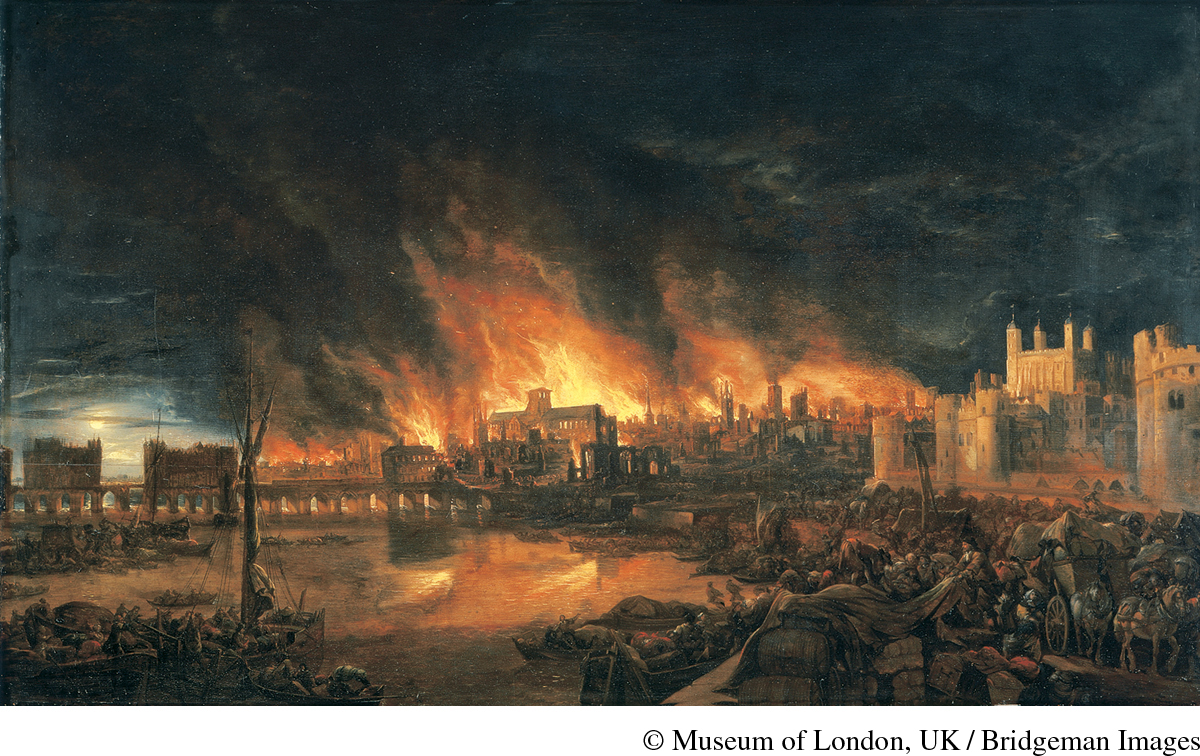Restoration and Revolution Again
Printed Page 518
Important EventsRestoration and Revolution Again
England’s traditional monarchical form of government was restored in 1660 under Charles II (r. 1660–1685). More than a thousand Puritan ministers lost their positions, and attending a service other than one conforming with the Book of Common Prayer was illegal after 1664. Two natural disasters in quick succession posed new challenges. The plague struck in 1665, claiming more than thirty thousand victims in just a few months and forcing Charles and Parliament to flee from London. Then in 1666, the Great Fire swept the city. Some saw these disasters as punishment for the sins of the Cromwell era, others as an ill omen for Charles’s reign.
Many in Parliament feared that Charles II wanted to emulate Louis XIV. In 1670, Charles made a secret agreement, soon leaked, with Louis in which he promised to announce his conversion to Catholicism in exchange for money for a war against the Dutch. Charles never proclaimed himself a Catholic, but in his Declaration of Indulgence (1673) he did suspend all laws against Catholics and Protestant dissenters. Parliament refused to continue funding the Dutch war unless Charles rescinded his Declaration of Indulgence. Asserting its authority further, Parliament passed the Test Act in 1673, requiring all government officials to profess allegiance to the Church of England and in effect disavow Catholic doctrine. Then in 1678, Parliament precipitated the so-called Exclusion Crisis by explicitly denying the throne to a Roman Catholic. This action was aimed at the king’s brother and heir, James, an open convert to Catholicism. Charles refused to allow it to become law.
The dynastic crisis over the succession of a Catholic gave rise to two distinct factions in Parliament: the Tories, who supported a strong, hereditary monarchy and the restored ceremony of the Church of England, and the Whigs, who advocated parliamentary supremacy and toleration of Protestant dissenters such as Presbyterians. Both labels were originally derogatory: Tory meant an Irish Catholic bandit; Whig was the Irish Catholic designation for a Presbyterian Scot. The Tories favored James’s succession despite his Catholicism, whereas the Whigs opposed a Catholic monarch.

When James II (r. 1685–1688) succeeded his brother, he seemed determined to force Catholicism on his subjects. Tories and Whigs joined together when a male heir—who would take precedence over James’s two adult Protestant daughters—was born to James’s second wife, an Italian Catholic, in 1688. They invited the Dutch ruler William, prince of Orange, and his wife, James’s older daughter, Mary, to invade England. Mary was brought up as a Protestant and was willing to act with her husband against her father’s pro-Catholic policies. James fled to France, and Parliament offered the throne jointly to William (r. 1689–1702) and Mary (r. 1689–1694) on the condition that they accept a bill of rights guaranteeing Parliament’s full partnership in a constitutional government.
In the Bill of Rights (1689), William and Mary agreed not to raise a standing army or to levy taxes without Parliament’s consent. They also agreed to call meetings of Parliament at least every three years, to guarantee free elections to parliamentary seats, and to abide by Parliament’s decisions. The agreement gave England’s constitutional government a written, legal basis by formally recognizing Parliament as a self-contained, independent body that shared power with the rulers. Victorious supporters of the coup declared it the Glorious Revolution because it was achieved with so little bloodshed (at least in England).
The propertied classes who controlled Parliament prevented any resurgence of the popular turmoil of the 1640s. The Toleration Act of 1689 granted all Protestants freedom of worship, though non-Anglicans (those not in the Church of England) were still excluded from the universities; Catholics got no rights but were more often left alone to worship privately. When the Catholics in Ireland rose to defend James II, William and Mary’s troops savagely suppressed them.